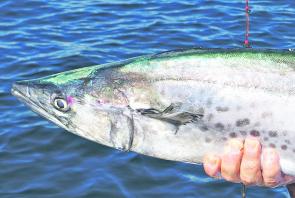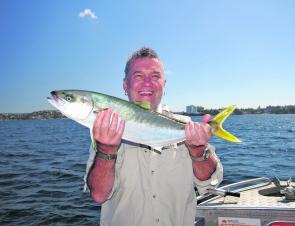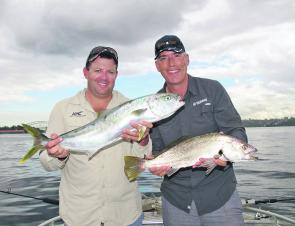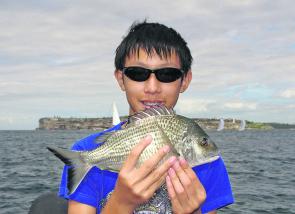With a brief respite from the rain, the water has cleared up nicely and the fishing is on fire. What a weird season it has been, though.
Extra-warm water around 25° has attracted some tropical species like Watson’s leaping bonito, samson fish and spotted mackerel. We caught a thresher shark at Old Mans Hat and to the best of my research, there has never been one recorded from inside the Heads before.
The kings aren’t huge fans of 25° water so the numbers have been down but the average size has been well up. We have caught more over 1m than any other season.
The anomalies in all this warm water action have been hairtail and dory, normally considered Winter fish.
All the estuary fish have been on fire with an above-average run of jewies, stacks of bream which have just moved into the lower reaches for spawning, and oodles of flatties.
The spotted mackerel have been taking live yakkas and trolled minnow lures. The last substantial run of spotties in Sydney was in 1999 during what was described as a long and strong la Nina event.
The current la Nina has also been described by the BOM as long and strong, with nothing similar in between this and the 1999 one. There is a fair chance that the occurrence of spotties in Sydney correlates with floods pushing them out of Queensland and northern NSW and extra-warm Sydney waters – both caused by La Nina.
Spotties grow to 9kg but are common between 3kg and 5kg, which is in line with what we have been catching in the Harbour. They are reliable targets in Moreton Bay in Summer and regularly range south as far as South West Rocks.
Like their close relatives the Spanish mackerel, they have horrible teeth that will slash the heaviest of nylon trace and careless fingers.
Wire trace is a catch-22. Without it you will get bitten off a lot and with it you will get a lot fewer bites. Pelagics, being sight feeders, are very wire-shy.
If you are bait fishing then it is almost a must.
Lure fishing is more forgiving in that the fish is usually lip-hooked and the teeth do not come in contact with the line.
Between first light and sunrise and from sunset to last light have been the most productive periods for lure fishing.
Trolling deep-diving minnow lures has been the most successful method. When they are working in schools on the surface, metal slugs or spoons are very effective.
Bait fishing for spotties is very successful if it’s done properly.
Firstly, you need a good berley trail. A cube trail is better than a mash and chopped pilchards or tuna cubes are good options.
A whole pilchard on ganged hooks, half a pilchard on a single hook or cubes of whatever you are berleying with make good bait.
If you opt for a ganged-hook rig you might get away without wire but with the single-hook rigs it is a must.
An unweighted bait is the preferred method but if the current is strong you might need a small sinker. It is important that your bait is not on the bottom.
Live bait is very successful in attracting strikes but it’s hard to get a hook-up. Spotties are like tailor in the way they slash bait in half and often they don't come back for the rest.
If you put the hook through the tail end of the bait the mackerel will bite the head off; if you put it through the head they will bite off the tail. And if you put one hook in the head and one in the tail end they won’t bite it at all!
I’m convinced that both tailor and spotties can see the hook and are put off by it. One way around this is to use small live baits and keep the hook size to the minimum practical. This way they will be more inclined to eat it whole rather than slashing it in half.
Bled, iced and then filleted and skinned, spotties make exceptional table fish but be careful not to overcook them.
When it comes to landing spotties, go for the small hand gaff (assuming you intend to keep the fish) rather than a net. Their design and fighting characteristics make them very hard to get into a net unless it is very large and deep.
By-catch for us has included tailor, bonito, mack tuna, trevally and kingies.
The bream have moved down in big numbers and are sitting in the deep water in the lower reaches.
They are ravenous and eating anything that is put in front of them.
A good indication of their abundance is the fact that we are regularly picking them up on baits aimed at kingfish and rigged on 8/0 hooks. When this happens you know that there is a frenzy going on down there.
If you want to target them more seriously, fish the deep holes and channels east of the bridge with prawns, mussels or chicken gut.
May should be hot for rock fishos wash fishing with bread baits and beach fishos using worms – the bream should be on tap.
Reads: 1385
Wire is a necessity for spotted mackerel.

The Workin’ Class Man wets a line – Jimmy Barnes with a Harbour king.

Nick and Andrew from the TV show Hook, Line and Sinker with a king and a school mulloway.

Bream have moved down the Harbour in big numbers.

The kings aren’t huge fans of 25° water so the numbers have been down but the average size has been well up.




